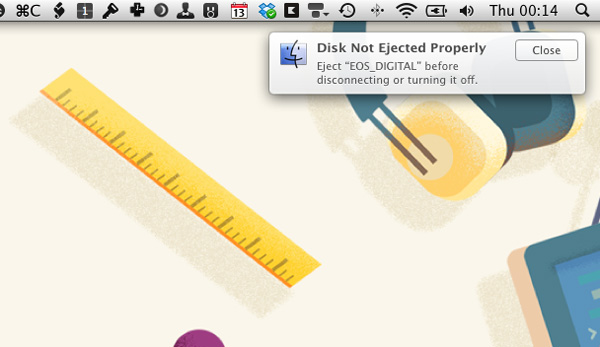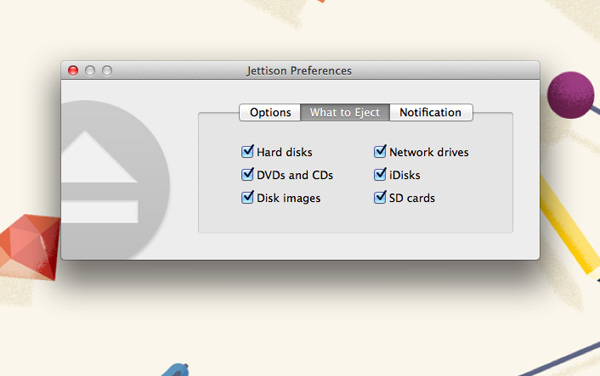Jettison
The Problem
Most MacBook users are familiar with the Disk Not Ejected Properly notification. Getting an alert when you rip a USB key out while your still running Mac is one thing, but getting one after you delicately unplug your external hard drives from your sleeping Mac so that you can put it in your bag is a different story.
The Solution
Jettison is a lightweight app, available for $1.99, that solves this problem. It lives in your menu bar and detects when your Mac is going to sleep. When it does, it unmounts all your external volumes. This means you can unplug your external drives without having to wake your Mac to eject them.Even better, if you put your Mac to sleep but decide not to unplug everything, Jettison will remount them automatically.
Using Jettison is simple. Download and install it from either the Mac App Store or the developer’s website. Then in Jettison’s Preferences menu, select which external volumes you want ejected.

Caffeine
The Problem
Even with all the recent improvements in battery life, it is still a concern for most MacBook users. The speed a modern Mac with an SSD can wake means it is becoming less and less inconvenient to have your Mac go to sleep whenever it is not actively in use.There are occasions though, when it is essential that your Mac stays awake; perhaps you are waiting for a file to download or an important Skype call. Whatever the event, there are few things more annoying than your computer going to sleep when you needed it to be awake.
The Solution
Caffeine is a free app that gives you the control you need. It is a menu bar app that lets you force your Mac to stay awake. When Caffeine is active it keeps your Mac awake, and when it is not, your Mac defaults to your power settings. You can be conservative with your power settings once you remember to click the little coffee cup icon when you want your Mac to stay awake.Tip: When the menu bar icon has coffee in it, Caffeine is active. When it is empty, it isn’t. This took me way too long to figure out when I first started using it.

Dwell Click
The Problem
If you use your Mac for more than a few hours a day, you will perform simple actions like single-clicks thousands of times. For most people, these repetitive movements are of no consequence.For sufferers of a repetitive strain injury (RSI), however, each one of these actions can bring intense pain. If you have an RSI, anything that can reduce the amount repetitive actions you make can have a huge difference.
The Solution
Dwell Click is an application that performs a click whenever you stop moving your cursor. By default this is a single-click but you can use the app to make a double-click or a control-click too. It is available for $4.99 with a free trial.Dwell Click works by single-clicking after a short delay wherever you stop your cursor. You can change the delay time in Dwell Click's Preferences. There is also an animation to let you know that Dwell Click has clicked. To stop the app from clicking when you finish moving your cursor, press Escape as you move.
To perform other types of clicks, press Function-Function . This brings up a menu that lets you double-click or control-click at the point the cursor was when you activated the menu. You can also map these clicks to keyboard shortcuts in Dwell Click’s preferences.
Dwell Click is a different way to interact with your Mac; it takes some getting use to. Cursor movements have to be made deliberately, otherwise you will find yourself jumping all over text documents!
If you suffer from an RSI, it is well worth getting passed this learning curve. My fellow Tuts+ author Richard Guay swears by it.
QuickRes
The Problem
Calling anything a problem with Apple’s retina MacBooks’ screens is an overstatement, however, switching between different resolutions is inconvenient. Retina screens emulate a lower-res display at double the resolution by default. Despite this, a lot of people prefer to use the extra pixels to get more screen space.The different resolution options supported by Retina Macs are suited to different tasks. No one resolution is right or wrong; having easy access to all is ideal. Digging into Apple’s System preferences is a very inneficient way to switch between them.
The Solution
QuickRes provides you with a menu bar icon that lets you quickly swap between all the different screen resolutions available. It is available for $2.99 from the developer.After you download and install QuickRes, switching resolutions is a matter of just clicking on a menu bar icon. If you want the most screen space possible, switch to 1:1 resolution, where as if you want the high-res effect of the retina display, switch to the emulated 2x resolution.
f.lux
The Problem
The human body’s sleep pattern is a delicate thing. Research has shown that exposure to screens late at night can interfere with your sleep. The ideal solution is to stop using screens after nightfall. For me, and I suspect for you, that is nearly impossible!Instead, you can change the colour temperature of the light you are exposed to. Similar research has shown that blue light is the worst offender when it comes to disrupting human sleep and so, by avoiding it, we can minimise the impact of late night Mac use.
The Solution
The free app f.lux automatically changes the colour temperature of your screen when the sun rises and sets. It warms the light from your screen to match the colour temperature of your inside lights during the night but cools the screen colour back down to match the sun during the day.f.lux uses your location to determine sunrise and sunset times and adjust your screen’s colour accordingly. In f.lux’s Preferences menu, you can specify your ambient light source and f.lux will compensate accordingly.
Tip: For photographers, and other people concerned about color accuracy, f.lux’s menu bar app allows you to disable it for an hour.

Conclusion
In this tutorial, I’ve shown you how to solve five common Mac problems just by installing simple applications. These are apps that my fellow Tuts+ authors and I love and use daily but do not justify a full tutorial.Do you have any niggles that are solved by a single simple app? Let me know in the comments.




